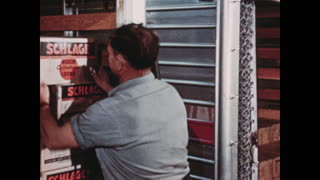This film “Wheels of Progress” (1952) was created by Hal A. McAlpin Productions for the Pacific Intermountain Express trucking company, later known simply as P.I.E. This was, at the time, one of the largest and most dynamic trucking companies in the USA. The film provides an overview of the transportation industry. The historical development of transportation is also traced in cartoon form, from canoes and rafts to railroads and automobiles and trucks. The film describes a highly organized transportation system operating 24/7, detailing the coordination required for specific schedules, the role of traffic managers, and the importance of efficient terminals. It shows the handling and loading of goods, safety practices, supervision, and the professionalism of drivers. The responsibilities and qualifications of drivers are highlighted, along with their ongoing training and defensive driving practices. The film also covers the maintenance and inspection processes at P.I.E.’s Denver maintenance shops. It concludes by underscoring the essential role of modern highway transportation in the American economy and daily life, emphasizing safety and efficiency. The film was written by William Baxter and Paul Satterfield, with narration by Ned LeFevre and cinematography by Chas. Welborne, Meredith Nicholson and Hal McAlpin.
00:00: Wagon wheels to truck tires. A visual introduction to transportation. Shots of the Pacific Daylight train, a United DC-6 airplane, and a 1945 Kenworth 500 truck on a rural highway.
1:01 – 2:00: Goods are transported across the United States, from cattle in Colorado, sides of beef (1:26) for hot dogs sold at Coney Island, and bales of cotton in Texas made into dresses in Los Angeles.
Woman eats a hot dog. 2:00: Historical development of transportation in America, from canoes and rafts to railroads and automobiles.
A streetcar or trolley car rumbles down a busy Los Angeles street, Subway Terminal Building visible in background on South Hill Street. 2:40: box of Washington State Apples on the move 3:01: Illustrations. Evolution of motorized carriers and the development of efficient highway systems.
4:01: Peterbilt 350 big rig on the move. Description of a highly organized transportation system with motorized carriers operating 24/7/365. P.I.E. central dispatch offices. 5:02: Examples of specific transportation schedules and the coordination required to keep goods moving. Teletype machine.
5:52: GMC / Dodge B-2 series Cannonball semi tractor trailer moves over Golden Gate Bridge. 6:00 : Dodge truck moving through Oakland streets on way to the port. Role of traffic managers, efficient freight terminals in long-haul operations.
7:00: Handling and loading of goods at terminals, including use of forklifts
8:00: Process of loading trailers and preparing them for long-haul journeys.
9:00: Importance of safety and coordination in motor transportation, with drivers performing thorough checks.
10:00 : Continuous supervision and monitoring of drivers and their routes.
Drive safely sign. Tachymeter monitors driver’s speed and distance. 11:00: Peterbilt 350 drives next to a police car. Professionalism and safety practices of drivers, including regular check stops.
12:00: Responsibilities and qualifications of professional drivers, emphasizing safety and experience.
Truck driver assists a motorist on a mountain pass with an overheated automobile. 13:00 Training and ongoing education for drivers. Driver undergoes medical check up with a doctor, taking his blood pressure reading.
14:00: Importance of defensive driving and alertness to prevent accidents.
15:00: Relay stations and rest periods to avoid driver fatigue.
16:00: P.I.E. mechanic renders aid to a motorist. Maintenance and inspection processes at Denver maintenance shops to ensure vehicle reliability.
17:00: Truck gets a car wash in a special machine. Detailed maintenance procedures, including cleaning, inspection, and overhaul of vehicles.
18:00: Rebuilding and reconditioning of vehicle parts to maintain fleet efficiency.
19:00 – 20:00: Assembly and inspection of reconditioned engines and other parts.
20:00 – 21:00: Final preparations and checks before vehicles return to service.
21:00: Streets of San Francisco. Importance of highway safety and the role of maintenance in preventing accidents.
22:00 – 22:29: Conclusion.
This film is part of the Periscope Film LLC archive, one of the largest historic military, transportation, and aviation stock footage collections in the USA. Entirely film backed, this material is available for licensing in 24p HD, 2k and 4k. For more information visit http://www.PeriscopeFilm.com


